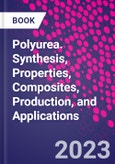Polyurea: Synthesis, Properties, Composites, Production, and Applications is a comprehensive and practical guide to polyurea, a material used for its exceptional properties and performance in a range of high value industrial applications. Sections cover polyurea formulations and properties, comparing aromatic polyurea with aliphatic polyurea and computation modeling of properties for polyurea and polyurea composites. This is followed by in-depth coverage of synthesis, structure and production methods of polyurea, with the connections between production, performance and properties examined thoroughly. Other sections explain the preparation, characterization, modeling and applications of polyurea and polyurea composites with the required properties for specific advanced applications.
Finally, environmental issues, recycling and future potential of polyurea are considered. This is a valuable resource for researchers and advanced students in polymer science, chemistry, composite science, civil engineering, materials science and mechanical engineering, as well as R&D professionals, engineers and industrial scientists with an interest in polyurea-based materials for advanced applications.
Please Note: This is an On Demand product, delivery may take up to 11 working days after payment has been received.
Table of Contents
Part I: Properties and types of polyurea
1. Formulations and Properties: Comparative review of aromatic polyurea versus aliphatic polyurea
2. Computational modelling of the properties of polyurea and its composites
Part II: Synthesis, structure, and production of polyurea
3. Raw materials, properties, and structure of polyurea?
4. Relationship between performance and properties of polyurea through different synthesis protocols: A review of different case studies
5. Production methods of polyurea and associated properties
Part III: Polyurea composites and nanocomposites
6. Synthesis and applications of polyurea composites based on fibers, microfillers, and functional materials
7. Polyurea nanocomposites: synthesis, functional properties, and applications
8. Ultraviolet (UV) resistivity of polyurea and polyurea composites: A comparison between aliphatic and aromatic polyurea composites
9. Fire retardant polyurea cement nanocomposites (polycrete) for construction and building applications
Part IV: Preparation, characterization, modelling, and applications of polyurea and polyurea composites
10. Polyurea microcapsules: Preparation, applications, and recent advances
11. Biomedical applications of polyurea and polyurea capsules
12. Mechanical properties and modelling of polyurea capsule-based self-healing composites
13. Shape memory and intrinsic self-healing polyurea systems
14. Polyurea in construction and building applications
15. Nanoscale Modeling of Shock Response of Polyurea
16. Preparation, characterization, and applications of polyurea foams
17. Applications of polyurea in blast and ballistic damage reduction
18. Industrial examples of polyurea versus other polymer coatings
Part V: Environmental issues, recycling, and future potential of polyurea
19. Fire-retardant polyurea composites
20. Current trends, prospects and sustainability of Polyurea and its reinforced composites
Authors
Pooria Pasbakhsh Research Fellow, Faculty of Engineering and Information Technology The University of Melbourne.Prof. Pooria holds a bachelor's degree in Materials Science and Engineering with a focus on Ceramics, a master's degree in Metallurgy and Materials Selection, and a Ph.D. in Polymer Composites. With over 17 years of research, academic, and industrial experience, he has worked on numerous industrial, government-funded, and research projects in various countries, including Australia, Malaysia, Italy, the UK, Denmark, Singapore, and Iran. His areas of expertise included polymers, fibers, coatings, minerals, nanomaterials, biomedical applications, fuel cells, building materials, and composites. Throughout his career, he has held positions as an Associate Professor at Monash University Malaysia, a postdoctoral researcher at the University of Adelaide, and a Technical Sales Specialist at Anton Paar Australia. Additionally, he has been recognized as one of the "World's Top 2% Scientists� since 2020 for his research impact in the fields of "Materials,� "Polymers,� and "Chemistry,� according to data released by Stanford University and Elsevier.
Damith Mohotti Senior Lecturer and Engineering Consultant, School of Civil Engineering and IT, UNSW Canberra, Australian Defence Force Academy, Australia. Dr. Damith Mohotti is a Senior Lecturer and an Engineering Consultant in the School of Civil Engineering and IT at UNSW Canberra at the Australian Defence Force Academy. An expert in protective structures, advanced engineering simulations, structural engineering, and engineering materials, his current research interests include blast and impact loading on structures, development of smart materials, and high strain rate behavior of engineering materials. Dr. Mohotti was a key member of the Defence Science and Technology Organisation (DMTC) Eureka Prize winning team for Outstanding Science in Safeguarding Australia in 2013. In addition to his academic experience and consultancy work in engineering and the defence sector, he has worked in the construction and consultation industries for many years holding different positions. Khanisya Palaniandy PhD candidate, School of Engineering, Monash University Malaysia, Malaysia. Khanisya Palaniandy is a PhD candidate in the School of Engineering at Monash University Malaysia. She has worked as a research assistant in the nanocomposites lab under an international industrial grant for a project on polyurea, and has also gained experience in mathematical modelling of colloidal particles and designing chemical production plants. Her current research focus is on polyurea nanocomposites for multifunctional coating applications. Sheik Ambarine Banon Auckloo PhD candidate, School of Engineering, Monash University Malaysia, Malaysia. Sheik Ambarine Banon Auckloo is a PhD candidate in the School of Engineering at Monash University Malaysia. She has worked on a research project on the design of a Reaction Injection Molding (RIM) system for production of polyurea, which led to a scholarship from Monash University and an international industrial grant for further research studies in polyurea manufacturing. Her research focuses on various manufacturing processes to produce polyurea, from design, manufacturing, and characterization, to application in real-world scenarios.







